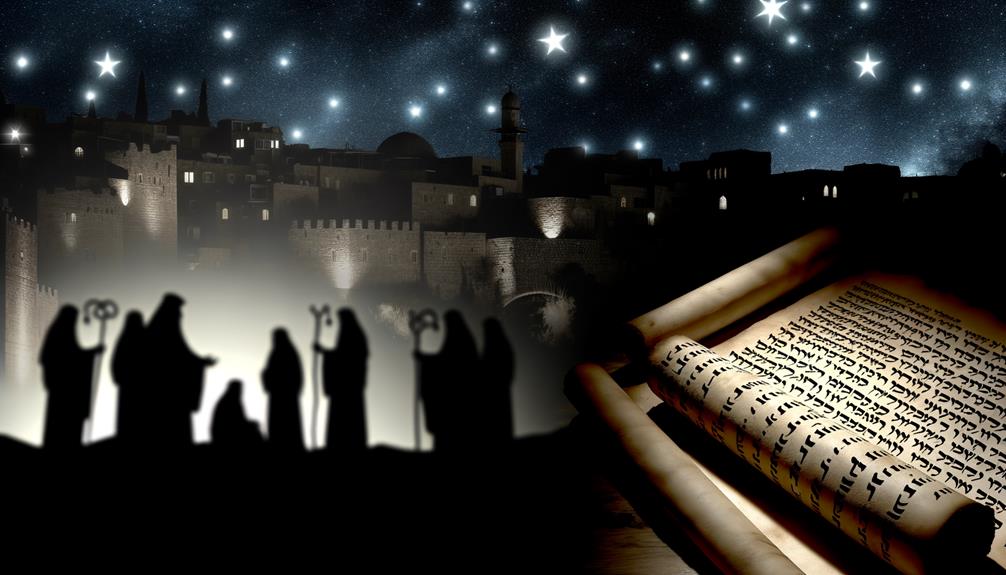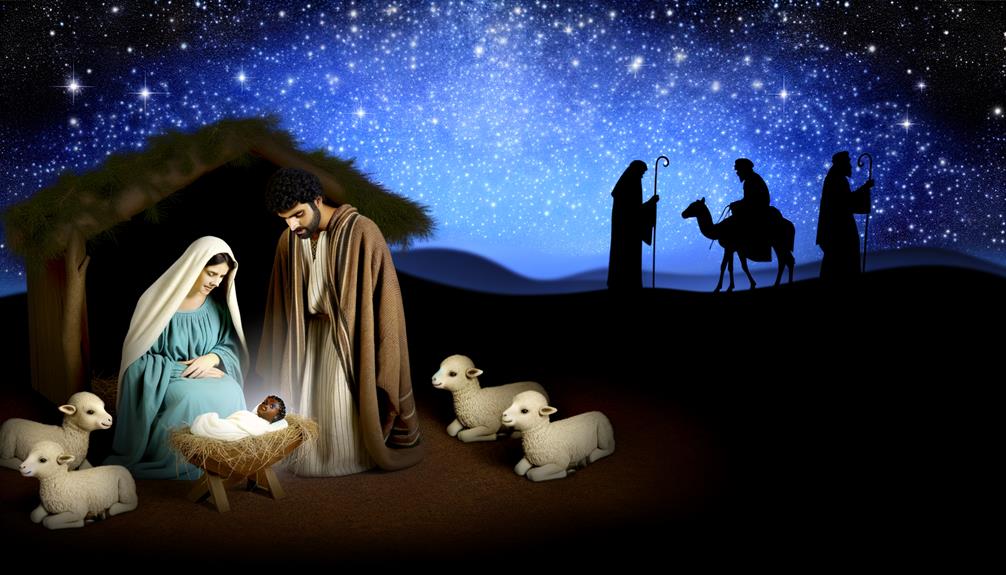Advent Meaning in Bible Verse: Coming of Christ
Advent, from a biblical perspective, signifies a dual anticipation: the initial coming of Jesus Christ and His promised return (Matthew 24:30-31, 1 Thessalonians 4:16-17). Rooted in Old Scriptures prophecies, Advent encapsulates the hope and restoration envisioned by prophets like Isaiah and Jeremiah (Isaiah 9:6-7, Jeremiah 29:11).
The birth narratives in Matthew and Luke emphasize fulfillment of these prophecies, setting the stage for a Messiah who brings justice and peace (Isaiah 40:31, Micah 5:2). Understanding Advent involves exploring these themes of hope, vigilance, and spiritual readiness woven throughout scripture.
There is much more to uncover.

Biblical Meaning of Advent: The First and Second Coming of Christ
| Interpretation | Meaning | Explanation |
|---|---|---|
| First Coming of Christ | Refers to the birth of Jesus Christ, the Messiah. | The Advent season commemorates the coming of Jesus into the world as a fulfillment of Old Testament prophecies, such as in Isaiah 7:14 (“The virgin will conceive and give birth to a son, and will call him Immanuel”). |
| Second Coming of Christ | Points to the future return of Christ in glory and judgment. | In addition to celebrating Christ’s birth, Advent also looks forward to the second coming of Christ, as described in Revelation 22:12, where Jesus says, “Behold, I am coming soon!” |
| Time of Preparation | A period of spiritual reflection and readiness for Christ’s coming. | Advent is a time for Christians to prepare their hearts for Christ’s coming, much like John the Baptist prepared the way for Jesus by calling people to repentance in Matthew 3:3. |
| Hope and Expectation | Represents the hope and expectation of God’s promises being fulfilled. | Advent brings a focus on the hope of salvation through Christ, fulfilling God’s promise of a Savior, seen in verses like Isaiah 9:6, which prophesies the coming of the “Prince of Peace.” |
| Light Overcoming Darkness | Symbolizes the light of Christ overcoming the darkness of the world. | The birth of Jesus, celebrated during Advent, represents light entering the world, as seen in John 1:9, which refers to Jesus as the “true light” that gives light to everyone. |
Hope in the Old Testament

The theme of hope permeates the Old Scripture, manifesting prominently in the prophetic literature as a promise of future restoration and divine intervention (Isaiah 40:31, Jeremiah 29:11).
This hope is not a mere wishful sentiment but a profound assurance grounded in God’s covenantal promises.
Isaiah’s proclamation of renewed strength for those who wait upon the Lord (Isaiah 40:31) and Jeremiah’s assurance of plans for welfare and a hopeful future (Jeremiah 29:11) illustrate the enduring faith in divine fidelity.
These passages collectively reflect an eschatological vision where adversity is temporary and divine salvation is imminent.
Therefore, the Old Testament encapsulates a theology of hope, offering a resilient anchor amid historical and existential uncertainties.
Prophecies of the Messiah

Building upon the Old Scripture’s theme of hope, the prophetic texts also foretell the coming of a Messiah who would fulfill God’s promises of redemption and restoration (Isaiah 9:6-7, Micah 5:2).
These prophecies articulate a vision of a divinely anointed leader who would bring justice, peace, and eternal governance. Isaiah 9:6-7 speaks of a ‘Wonderful Counselor, Mighty God, Everlasting Father, Prince of Peace,’ whose reign would establish justice forever.
Similarly, Micah 5:2 predicts the Messiah’s birthplace as Bethlehem, underscoring the specificity and intentionality of God’s plan.
These passages offer a robust theological foundation, highlighting an eschatological hope that shapes the Advent season’s anticipation, rooted in the Old Covenant’s prophetic literature.
The Birth of Jesus

Consistently celebrated in Christian tradition, the narrative of Jesus’ birth is meticulously chronicled in the Gospels of Matthew and Luke, offering theological insights and historical context.
Matthew 1:18-25 and Luke 2:1-20 provide complementary accounts emphasizing different aspects. Matthew highlights the fulfillment of Old Covenant prophecies, portraying Jesus as the prophesied Messiah, while Luke emphasizes the humble circumstances of Jesus’ birth, underscoring themes of hope and salvation for the marginalized.
The angelic announcement to shepherds (Luke 2:8-14) and the visit of the Magi (Matthew 2:1-12) illustrate divine revelation to both Jews and Gentiles.
Consequently, these narratives collectively affirm the universal significance of Jesus’ birth within the Christian faith.
Anticipation of His Return

Christian eschatology, deeply rooted in biblical scripture, emphasizes the anticipation of Jesus’ return as a pivotal event in the fulfillment of God’s redemptive plan.
Key texts such as Matthew 24:30-31 and 1 Thessalonians 4:16-17 underscore the Second Coming, portraying it as an imminent and transformative event. This anticipation shapes Christian doctrine and practice, reinforcing themes of vigilance and hope (Titus 2:13).
The eschatological promise of Christ’s return serves as a cornerstone for understanding the ultimate restoration of creation (Revelation 21:1-4). By fostering a forward-looking faith, this anticipation invites believers to remain steadfast and expectant, aligning their lives with the divine narrative of redemption and renewal outlined in scripture.
Living the Advent Message

Embodying the Advent message involves integrating themes of hope, vigilance, and preparation into daily life, as reflected in biblical exhortations such as Romans 13:11-12 and 1 Peter 1:13. These scriptures emphasize the urgency of awakening from spiritual slumber and girding the mind for Christ’s return. An analytical approach reveals that living the Advent message requires a transformative lifestyle, characterized by moral alertness and spiritual readiness.
| Theme | Scriptural Reference |
|---|---|
| Hope | Romans 13:11-12 |
| Vigilance | 1 Peter 1:13 |
| Preparation | Matthew 24:44 |
| Transformation | Ephesians 4:22-24 |
The table above outlines the core themes and their scriptural foundations, guiding believers in embodying the essence of Advent in their daily conduct.
Conclusion
In sum, the concept of advent in biblical scripture encompasses profound themes of hope, fulfillment, and anticipation. These themes are further echoed and celebrated in the traditions and practices of the Advent season in many Christian communities. The anticipation of the coming of Jesus Christ, and the hope and fulfillment of the promised Messiah, are central to the Advent and Christmas meaning. This period of reflection and preparation allows believers to delve deeper into the significance of these core tenets of their faith, and to experience the joy and celebration of the Christmas season with a renewed sense of purpose and understanding.
From Old Testament prophecies to the birth of Jesus and the expected Second Coming, the advent message invites a life of vigilant faith and preparedness.
As the adage goes, ‘Hope springs eternal,’ reflecting the enduring nature of the advent promise.
The study of these scriptural elements offers a rich understanding of the theological and historical significance of advent.






